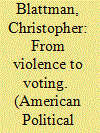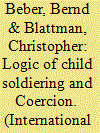|
|
|
Sort Order |
|
|
|
Items / Page
|
|
|
|
|
|
|
| Srl | Item |
| 1 |
ID:
145081


|
|
|
|
|
| Summary/Abstract |
States and aid agencies use employment programs to rehabilitate high-risk men in the belief that peaceful work opportunities will deter them from crime and violence. Rigorous evidence is rare. We experimentally evaluate a program of agricultural training, capital inputs, and counseling for Liberian ex-fighters who were illegally mining or occupying rubber plantations. Fourteen months after the program ended, men who accepted the program offer increased their farm employment and profits, and shifted work hours away from illicit activities. Men also reduced interest in mercenary work in a nearby war. Finally, some men did not receive their capital inputs but expected a future cash transfer instead, and they reduced illicit and mercenary activities most of all. The evidence suggests that illicit and mercenary labor supply responds to small changes in returns to peaceful work, especially future and ongoing incentives. But the impacts of training alone, without capital, appear to be low.
|
|
|
|
|
|
|
|
|
|
|
|
|
|
|
|
| 2 |
ID:
109932


|
|
|
|
|
| Publication |
2011.
|
| Summary/Abstract |
What are the impacts of war on the participants, and do they vary by gender? Are ex-combatants damaged pariahs who threaten social stability, as some fear? Existing theory and evidence are both inconclusive and focused on males. New data and a tragic natural quasi-experiment in Uganda allow us to estimate the impacts of war on both genders, and assess how war experiences affect reintegration success. As expected, violence drives social and psychological problems, especially among females. Unexpectedly, however, most women returning from armed groups reintegrate socially and are resilient. Partly for this reason, postconflict hostility is low. Theories that war conditions youth into violence find little support. Finally, the findings confirm a human capital view of recruitment: economic gaps are driven by time away from civilian education and labor markets. Unlike males, however, females have few civilian opportunities and so they see little adverse economic impact of recruitment.
|
|
|
|
|
|
|
|
|
|
|
|
|
|
|
|
| 3 |
ID:
090807


|
|
|
|
|
| Publication |
2009.
|
| Summary/Abstract |
What is the political legacy of violent conflict? I present evidence for a link from past violence to increased political engagement among excombatants. The evidence comes from northern Uganda, where rebel recruitment generated quasiexperimental variation in who was conscripted by abduction. Survey data suggest that abduction leads to substantial increases in voting and community leadership, largely due to elevated levels of violence witnessed. Meanwhile, abduction and violence do not appear to affect nonpolitical participation. These patterns are not easily explained by conventional theories of participation, including mobilization by elites, differential costs, and altruistic preferences. Qualitative interviews suggest that violence may lead to personal growth and political activation, a possibility supported by psychological research on the positive effects of traumatic events. Although the generalizability of these results requires more evidence to judge, the findings challenge our understanding of political behavior and point to important new avenues of research.
|
|
|
|
|
|
|
|
|
|
|
|
|
|
|
|
| 4 |
ID:
131502


|
|
|
|
|
| Publication |
2014.
|
| Summary/Abstract |
Dispute resolution institutions facilitate agreements and preserve the peace whenever property rights are imperfect. In weak states, strengthening formal institutions can take decades, and so state and aid interventions also try to shape informal practices and norms governing disputes. Their goal is to improve bargaining and commitment, thus limiting disputes and violence. Mass education campaigns that promote alternative dispute resolution (ADR) are common examples of these interventions. We studied the short-term impacts of one such campaign in Liberia, where property disputes are endemic. Residents of 86 of 246 towns randomly received training in ADR practices and norms; this training reached 15% of adults. One year later, treated towns had higher resolution of land disputes and lower violence. Impacts spilled over to untrained residents. We also saw unintended consequences: more extrajudicial punishment and (weakly) more nonviolent disagreements. Results imply that mass education can change high-stakes behaviors, and improving informal bargaining and enforcement behavior can promote order in weak states.
|
|
|
|
|
|
|
|
|
|
|
|
|
|
|
|
| 5 |
ID:
117992


|
|
|
|
|
| Publication |
2013.
|
| Summary/Abstract |
Why do armed groups recruit large numbers of children as fighters, often coercively? The international community has tried to curb these crimes by shaming and punishing leaders who commit them-in short, making the crimes costlier. Are these policies effective and sufficient? The answer lies in more attention to the strategic interaction between rebel leaders and recruits. We adapt theories of industrial organization to rebellious groups and show how, being less able fighters, children are attractive recruits if and only if they are easier to intimidate, indoctrinate, and misinform than adults. This ease of manipulation interacts with the costliness of war crimes to influence rebel leaders' incentives to coerce children into war. We use a case study and a novel survey of former child recruits in Uganda to illustrate this argument and provide hard evidence not only that children are more easily manipulated in war, but also how-something often asserted but never demonstrated. Our theory, as well as a new "cross-rebel" data set, also support the idea that costliness matters: foreign governments, international organizations, diasporas, and local populations can discourage child recruitment by withholding resources or punishing offenders (or, conversely, encourage these crimes by failing to act). But punishing war crimes has limitations, and can only take us so far. Children's reintegration opportunities must be at least as great as adults' (something that demobilization programs sometimes fail to do). Also, indoctrination and misinformation can be directly influenced. We observe grassroots innovations in Uganda that could be models for the prevention and curbing of child soldiering and counterinsurgency generally.
|
|
|
|
|
|
|
|
|
|
|
|
|
|
|
|
| 6 |
ID:
152304


|
|
|
|
|
| Summary/Abstract |
Riots, murders, lynchings, and other forms of local violence are costly to security forces and society at large. Identifying risk factors and forecasting where local violence is most likely to occur should help allocate scarce peacekeeping and policing resources. Most forecasting exercises of this kind rely on structural or event data, but these have many limitations in the poorest and most war-torn states, where the need for prediction is arguably most urgent. We adopt an alternative approach, applying machine learning techniques to original panel survey data from Liberia to predict collective, interpersonal, and extrajudicial violence two years into the future. We first train our models to predict 2010 local violence using 2008 risk factors, then generate forecasts for 2012 before collecting new data. Our models achieve out-of-sample AUCs ranging from 0.65 to 0.74, depending on our specification of the dependent variable. The models also draw our attention to risk factors different from those typically emphasized in studies aimed at causal inference alone. For example, we find that while ethnic heterogeneity and polarization are reliable predictors of local violence, adverse economic shocks are not. Surprisingly, we also find that the risk of local violence is higher rather than lower in communities where minority and majority ethnic groups share power. These counter-intuitive results illustrate the usefulness of prediction for generating new stylized facts for future research to explain. Ours is one of just two attempts to forecast local violence using survey data, and we conclude by discussing how our approach can be replicated and extended as similar datasets proliferate.
|
|
|
|
|
|
|
|
|
|
|
|
|
|
|
|
| 7 |
ID:
130473


|
|
|
|
|
| Publication |
2014.
|
| Summary/Abstract |
Every year, wealthy countries spend billions of dollars to help the world's poor, paying for cows, goats, seeds, beans, textbooks, business training, microloans, and much more. Such aid is designed to give poor people things they can't afford or the tools and skills to earn more. Much of this aid undoubtedly works. But even when assistance programs accomplish things, they often do so in a tremendously expensive and inefficient way. Part of this is due to overhead, but overhead costs get far more attention than they deserve. More worrisome is the actual price of procuring and giving away goats, textbooks, sacks of beans, and the like.
Most development agencies either fail to track their costs precisely or keep their accounting books confidential, but a number of candid organizations have opened themselves up to scrutiny. Their experiences suggest that delivering stuff to the poor is a lot more expensive than one might expect.
Take cows. Many Western organizations give poor families livestock, along with training in how to raise and profit from the animals. Cows themselves usually cost no more than a few hundred dollars each, but delivering them -- targeting recipients, administering the donations, transporting the animals -- gets expensive. In West Bengal, India, for example, the nonprofit Bandhan spends $331 to get $166 worth of local livestock and other assets to the poor, according to a report by the rating agency Micro-Credit Ratings International. Yet even this program sounds like a bargain compared to others. In Rwanda, a study led by the economist Rosemary Rawlins found that the cost of donating a pregnant cow, with attendant training classes and support services, through the charity Heifer International can reach $3,000.
|
|
|
|
|
|
|
|
|
|
|
|
|
|
|
|
|
|
|
|
|